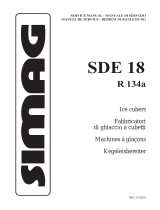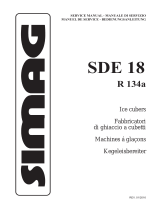MACHINE GAS TYPE COMPRESSOR
COMPRESSOR
POWER
IN WATT *
MAX.
AMPER
MEDIUM
AMPERE
CONDENSING
PRESSURE
STARTING
CYCLE (BARS)
EVAPORATION
TEMPERATU-
RE STARTING
CYCLE (°C)
CONDENSING
PRESSURE
END CYCLE
(BARS)
EVAPORATION
TEMPERATURE
END CYCLE
(°C)
ELECTR.
CONSUMPTION
ON 24 HRS/KW
CUBES FOR
CYCLES AND
WEIGHT SINGLE
CUBES IN GRAM
WATER
CONSUMPTION
**
N21S A 134A ELECTROLUX GL60TB
220/50HZ 160 2A 1,8A 11,5 -3,3 9-17 7,5 15/19G 6
N21S W 134A ELECTROLUX GL60TB
220/50HZ 160 2A 1,8A 9,5 -8 9-17 7,5 15/19G 21
N25S A 134A ELECTROLUX GL45TB
220/50HZ 140 1,6A 1,4A 11 -2 9-13 5.8 15/17g 2,8
N25S W 134A ELECTROLUX GL45TB
220/50HZ 140 1,4A 1,2A 8-10 08-10 -13 5.3 15/17g 15
N25L A 134A ELECTROLUX GL45TB
220/50HZ 140 1,4A 1,2A 8-10 08-10 -13 5.3 15/17g 2,8
N25L W 134A ELECTROLUX GL45TB
220/50HZ 140 1,4A 1,2A 8-10 08-10 -13 5.3 15/17g 15
N35S A 134A ELECTROLUX GL90TB
220/50HZ 220 2,7A 2,1A 14 -2 10 -15 8.6 20/17g 4,7
N35S W 134A ELECTROLUX GL90TB
220/50HZ 220 2,5A 2.0A 10 -4 8-10 -16 8.2 20/17g 22
N45S A 134A ELECTROLUX GL90TB
220/50HZ 220 2,4A 2,1A 12 -4 9-13 8.0 35/17g 5,5
N45S W 134A ELECTROLUX GL90TB
220/50HZ 220 3,6A 2A 9-6 9-14 7.8 35/17g 30
N45L A 134A ELECTROLUX GL90TB
220/50HZ 220 2,4A 2,1A 12 -4 9-13 8.0 35/17g 5,5
N45L W 134A ELECTROLUX GL90TB
220/50HZ 220 3,6A 2A 9-6 9-14 7.8 35/17g 30
N55S A 134A UNITE' HERMETIQUE
CAE4448Y 220/50HZ 360 3,6A 3A 12.5 -6 9-16 12 35/17g 7
N55S W 134A UNITE' HERMETIQUE
CAE4448Y 220/50HZ 360 3,6A 2,8A 9-8 11 -18 11.5 35/17g 37
N55L A 134A UNITE' HERMETIQUE
CAE4448Y 220/50HZ 360 3,6A 3A 12.5 -6 9-16 12 35/17g 7
N55L W 134A UNITE' HERMETIQUE
CAE4448Y 220/50HZ 360 3,6A 2,8A 9-8 11 -18 11.5 35/17g 37
N50BI A 134A UNITE' HERMETIQUE
GP14TB 340 3,7A 3,3A 13 -5 9-16 14.5 35/17g 7
N50BI W 134A UNITE' HERMETIQUE
GP14TB 340 3.6A 3A 9-8 9-16 13.5 35/17g 37
N70S A 134A UNITE' HERMETIQUE
CAE4448Y 220/50HZ 360 3,6A 3,3A 13.5 -4 11 -12 12.5 60/17g 9
N70S W 134A UNITE' HERMETIQUE
CAE4448Y 220/50HZ 360 3,6A 3A 9-6 9-12 12.2 60/17g 40
N90S A 134A UNITE' HERMETIQUE
CAJ4461Y 220/50HZ 410 4,7A 4A 15 -3 11 -13 16 60/17g 11
N90S W 134A UNITE' HERMETIQUE
CAJ4461Y 220/50HZ 410 4,2A 3,8A 9-5 9-14 15.5 60/17g 48
N140 A 134A UNITE' HERMETIQUE
CAJ4511Y 220/50HZ 640 5,2A 4,5A 11.5 -8 9.5 -17 23.5 90/17g 19
N140 W 134A UNITE' HERMETIQUE
CAJ4511Y 220/50HZ 640 4,8A 4A 9-10 9-18 22.5 90/17g 84
“N” TECHNICAL DATA FOR ICE CUBES MACHINE
MEDIUM AND MAXIMUM ABSORBITION ON THE "N" LINE MACHINES AT 32°C ROOM TEMPERATURE
CONDENSING PRESSURE AND EVAPORATOR TEMPERATURE AT STARTING AND END CYCLE AT 32°C ROOM TEMPERATURE
*ABSORVED POWER AT EVAPORATION TEMPERATURE OF -15°C ** EXPRESSED IN LITRES FOR HOUR WITH WATER TEMPERATURE OF 15°C AND AMBIENT TEMPERATURE OF 21°C





















